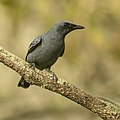Biology:Common cicadabird
| Common cicadabird | |
|---|---|

| |
| Scientific classification | |
| Domain: | Eukaryota |
| Kingdom: | Animalia |
| Phylum: | Chordata |
| Class: | Aves |
| Order: | Passeriformes |
| Family: | Campephagidae |
| Genus: | Edolisoma |
| Species: | E. tenuirostre
|
| Binomial name | |
| Edolisoma tenuirostre (Jardine, 1831)
| |
| Synonyms | |
|
Coracina tenuirostris | |
The common cicadabird (Edolisoma tenuirostre), also known as the slender-billed cicadabird, is a species of bird in the family Campephagidae. It is found in Australia , Indonesia, New Guinea, and the Solomon Islands. Its natural habitats are temperate forest and subtropical or tropical moist lowland forest.[2] The species is placed in the reinstated genus Edolisoma by most authors.[3] The common cicadabird was described as a "great speciator" by Mayr & Diamond (2001);[4] and Pedersen et al. (2018)[3] described how this species rapidly colonized and diversified across the Indo-Pacific island region and Australia in the Pleistocene.
Subspecies
Numerous subspecies have been described; the list below is sorted taxonomically:[5]
- E. t. edithae Stresseman, 1932 - southern Sulawesi
- E. t. pererratum Hartert, E., 1918 - Tukangbesi Islands, Indonesia
- E. t. kalaotuae Meise, 1929 - Kalaotoa in the Selayar Islands, Indonesia
- E. t. emancipatum Hartert, E., 1918 - Banggai Island, Indonesia
- E. t. grayi Salvadori, 1879 - Morotai to Bacan in the northern Maluku Islands, Indonesia
- E. t. obiense Salvadori, 1879 - Obi Islands, Indonesia
- E. t. amboiense (Hartlaub, 1865) - Buru, Ambon, Seram, and other Seram Sea islands, Indonesia
- E. t. matthiae Sibley, 1946 - Mussau and Emirau, Papua New Guinea
- E. t. heinrothi Stresseman, 1922 - New Britain and Lolobau, Papua New Guinea
- E. t. rooki Rothschild & Hartert, E., 1914 - Umboi, Papua New Guinea
- E. t. nehrkorni Salvadori, 1890 - Waigeo, western New Guinea
- E. t. numforanum (Peters, J.L. & Mayr, 1960) - Numfor, western New Guinea
- E. t. meyerii Salvadori, 1878 - Biak, western New Guinea
- E. t. aruense Sharpe, 1878 - southwestern and south-central New Guinea and the Aru Islands
- E. t. muellerii Salvadori, 1876 - most of New Guinea (aside from the south), Kofiau & Misool, Long, Sakar, and the D'Entrecasteaux Islands
- E. t. tagulanum Hartert, E., 1898 - Misima and Tagula, Papua New Guinea
- E. t. rostratum Hartert, E., 1898 - Rossel, Papua New Guinea
- E. t. melvillense (Mathews, 1912) - northern Australia from northeastern Western Australia to the Cape York Peninsula, south to northeast Queensland
- E. t. tenuirostre (Jardine, 1831) - eastern Australia from east-central Queensland south to southeast Victoria
The former subspecies E. t. nisorium was found to be of erroneous placement and to actually belong to the grey-capped cicadabird (E. remotum), and was thus moved to it by the International Ornithological Congress in 2022.[6]
Gallery
References
- ↑ BirdLife International (2017). "Edolisoma tenuirostre". IUCN Red List of Threatened Species 2017: e.T103702470A118729711. doi:10.2305/IUCN.UK.2017-3.RLTS.T103702470A118729711.en. https://www.iucnredlist.org/species/103702470/118729711. Retrieved 17 November 2021.
- ↑ BirdLife International.
- ↑ 3.0 3.1 Pedersen, M.P.; Irestedt, M.; Joseph, L.; Rahbek, C.; Jønsson, K.A. (2018). "Phylogeography of a 'great speciator' (Aves: Edolisoma tenuirostre) reveals complex dispersal and diversification dynamics across the Indo-Pacific". Journal of Biogeography 45 (4): 826–837. doi:10.1111/jbi.13182.
- ↑ Mayr, E.; Diamond, J.M. (2001). The Birds of Northern Melanesia: Speciation, Ecology and Biogeography. New York: Oxford University Press. ISBN 978-0-19-534966-5.
- ↑ "Bristlehead, butcherbirds, woodswallows, Mottled Berryhunter, ioras, cuckooshrikes – IOC World Bird List" (in en-US). https://www.worldbirdnames.org/new/bow/butcherbirds/.
- ↑ "Subspecies Updates – IOC World Bird List" (in en-US). https://www.worldbirdnames.org/new/updates/subspecies-2/.
External links
- ABID Images
- On the HBW Internet Bird Collection
- Species factsheet - BirdLife International
Wikidata ☰ {{{from}}} entry
 |




